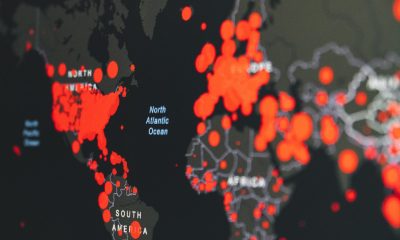Studying newly discovered planet could reveal how Earth formed
The small, cold exoplanet orbits a star visible from our planet with a similar temperature to our own Sun.
Published
4 months ago onBy
Talker News
By James Gamble via SWNS
Astronomers have discovered an exoplanet that could provide invaluable answers to how our own planet was formed.
The small, cold exoplanet orbits a star visible from our planet with a similar temperature to our own Sun and could shed light on the formation of Earth.
The discovery, from an international team of researchers from across the globe, is extremely rare in finding an exoplanet smaller and lighter than both Neptune and Uranus.
The star system where the planet is found also contains an outer, large companion a hundred times the mass of Jupiter.
The new planetary system was discovered around the star HD88986, which has a similar temperature to the Sun with a slightly larger radius.
The star is bright enough to be seen by keen observers at dark sky sites across the UK.

The researchers, from 31 scientific institutes across nine countries including Switzerland, Chile, the US, the UK and France, found the planetary system around the star to include a cold planet smaller than Neptune: HD88986b.
Dr. Neda Heidari, an Iranian fellow at the Institut d'astrophysique de Paris (IAP) who leads the new study, explained that HD88986b takes a peculiarly long time to orbit its sun.
"Most of the planets we've discovered and measured for their mass and radius have short orbits, typically less than 40 days," she said.
"To provide a comparison with our solar system, even Mercury, the closest planet to the Sun, takes 88 days to complete its orbit.
"This lack of detection for planets with longer orbits raises challenges in understanding how planets form and evolve in other systems and even in our solar system.
"HD88986b, with its orbital period of 146 days, has potentially the longest known orbit among the population of small planets with precise measurements."
The cold, Neptune-esque planet was detected with the assistance of a high-precision spectrograph - a machine that analyses wavelengths of light from exoplanets - at the Haute-Provence Observatory in France, called SOPHIE.
SOPHIE detects and characterizes exoplanets using the ‘radial-velocity method’; measuring tiny motion variations of the star induced by planets orbiting it.
These observations allowed the team to estimate the newly discovered planet's mass as being approximately 17 times that of Earth's.
Complementary observations obtained through the NASA space telescope TESS, and the European Space Agency’s (ESA) space telescope CHEOPS, showed that the planet likely 'transits' in front of its host star.
This occurs when its orbit passes on the line of sight between the Earth and the star, partially occulting the star and causing a decrease in its brightness that can be observed and quantified.
These observations from both satellites allowed the team to directly estimate the diameter of the planet as about twice that of Earth's.

The findings of the study, published in the journal Astronomy & Astrophysics, rely on more than 25 years of observations, also including data from ESA’s Gaia satellite and the Keck Telescope in Hawaii - making it one of the longest-ever studied exoplanet systems.
With an atmosphere temperature of only 190 degrees Celsius, HD88986b provides a rare opportunity to study the composition of the so-called 'cold' atmospheres, as most of the detected atmospheres for exoplanets are above 1,000 degrees Celsius.
Due to the gigantically wide orbit of the sub-Neptune HD88986b - as large as 60 percent of the distance between the Earth and the Sun - HD88986b probably underwent rare interactions with other planets that may exist in the planetary system, and weak loss of mass from the strong ultraviolet radiation of the central star.
It may therefore have retained its original chemical composition, allowing scientists to explore possible scenarios for the formation and evolution of this planetary system.
Dr. Thomas Wilson, a senior research fellow at the University of Warwick who co-led the analysis of satellite data, explained that continuing to study the exoplanet could help us learn more about the formation of our own planet.

“HD88986b is essentially a scaled-down Neptune, between the orbits of Mercury and Venus," he said.
"It becomes one of the best-studied small, cold exoplanets, paving the way for studying its atmosphere to understand the similarity to our own planet Earth.
"It also orbits a star with a similar temperature to the Sun making it a precursor to the Earth-like planets to be found by the PLATO space telescope."
The astronomers also revealed a second, outer companion around the central star in their study.
This exoplanet is particularly huge at more than 100 times the mass of Jupiter, and its orbit has a period of several decades.
The researchers say further observations are needed to understand its nature and better determine its properties.
“We collected data from telescopes pointing at HD88986 for over 25 years making this one of the longest-studied exoplanet systems," Dr. Wilson added.
"This wealth of data revealed a second outer companion more massive than Jupiter that may have been important for the formation of the Neptune-like planet in a similar way to Jupiter in our own Solar System."
Stories and infographics by ‘Talker Research’ are available to download & ready to use. Stories and videos by ‘Talker News’ are managed by SWNS. To license content for editorial or commercial use and to see the full scope of SWNS content, please email [email protected] or submit an inquiry via our contact form.
You may like


Cancer survivors from poorer places at higher risk of second cancer


Scientists estimate as much as 11M tons of plastic sitting on ocean floor


Scientists say this disease most likely to cause next global pandemic


Study finds longest recorded COVID infection lasted nearly two years


Scientists create family tree of coffee for clues to resist climate change


Tiny ingestible beads could help fight liver disease: study
Other Stories


Blood test can detect signs of knee condition 8 years before X-rays
Early detection could lead to treatments that slow the progression of the most common form of arthritis.


Man captures ultra rare albino squirrel on camera
The white squirrel has red eyes so is thought to be an albino squirrel.


Adorable dog kicks his leg while he walks
A video captured the pup bouncing along the street of his native China.


Woman with rare ‘Sleeping Beauty’ condition sleeps every four hours
She was diagnosed at age 18 after years of struggling to stay awake in school and nodding off during class.


97-year-old veteran receives WWII service medal 80 years later
"We’re all so proud of Eve."
Top Talkers

 Parenting1 week ago
Parenting1 week agoSingle mom details struggles of feeding her 12 kids

 Lifestyle1 week ago
Lifestyle1 week agoWoman regrets her tattoo nightmare: ‘It’s horrendous’

 Health5 days ago
Health5 days agoNew study reveals ‘old age’ begins later than it used to

 Wildlife4 days ago
Wildlife4 days agoClever elephant returns visitor’s shoe that fell into enclosure

 Good News4 days ago
Good News4 days agoDisabled student takes first steps in 10 years on graduation stage

 Animals13 hours ago
Animals13 hours agoAdorable dog kicks his leg while he walks

 Entertainment2 days ago
Entertainment2 days agoWhat is the perfect movie length?

 Broadcast19 hours ago
Broadcast19 hours agoAre allergies interfering with your social life?
